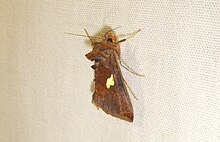Spring Hill Gold Owl
| Spring Hill Gold Owl | ||||||||||||
|---|---|---|---|---|---|---|---|---|---|---|---|---|

Spring heap gold owl ( Autographa bractea ) |
||||||||||||
| Systematics | ||||||||||||
|
||||||||||||
| Scientific name | ||||||||||||
| Autographa bractea | ||||||||||||
| ( Denis & Schiffermüller , 1775) |
The spring heap gold owl ( Autographa bractea ), also known as silver leaf gold owl or brown silver-spot humped owl , is a butterfly ( moth ) from the subfamily of the Plusiinae within the owl butterflies (Noctuidae).
features
butterfly
With a wingspan of 44 to 50 millimeters, the moths are one of the relatively large species from the subfamily of gold owls. The forewings are dark brown to purple-brown in color, the transverse lines indistinct. A shiny golden shimmering, teardrop-shaped blemish, which is cut straight against the front edge by the central vein, is characteristic of the species. Specimens with a silver instead of a golden blemish are called f. argentea and have a certain resemblance to the hawkweed silver owl ( Autographa aemula ). The hind wings are yellowish brown in color and have a slightly darkened outer edge. There is a dense tuft of hair on the head of the butterfly. The body is furry and has other smaller tufts of hair.
Egg, caterpillar, pupa
The greenish-yellow egg has a hemispherical shape and has weak ribs.
The caterpillars are gray-green in color. They have a thin, white topline, yellowish side stripes, white point warts with long hair, and red stigmas .
The green wing sheaths stand out from the black-brown colored pupa .
Similar species
- In Autographa excelsa , the teardrop-shaped blemish is smaller and more rounded, and there is a dark center line on the hind wings.
- The hawkweed silver owl ( Autographa aemula ) shows, in addition to the silver drop blemishes, a clearly darkened field near the apex .
Synonyms
- Plusia bractea
- Phytometra bractea
Geographical distribution and occurrence
The Quellhalden gold owl is common in Central Europe, especially in mountainous areas. In recent years it has expanded its range and it also migrates occasionally. In the Alps it can be found up to an altitude of 2600 meters, but higher low mountain ranges are its main occurrence area. In the east the species can be found as far as Central Asia. It prefers moist areas, such as moor meadows, brook and river bank areas, floodplains, meadow valleys and damp forest edges.
Way of life and development
The moths are active during the day, at dusk and at night. They fly towards artificial light sources and during the day they can be observed sucking on the flowers of forest pits ( Stachys sylvatica ), common soapwort ( Saponaria officinalis ) or carnations ( Dianthus ). The females lay the eggs on the forage plant, from which the caterpillars hatch in autumn. The leaves of a variety of low plants serve as a source of nutrition, such as:
- Hawkweed ( Hieracium )
- Coltsfoot ( Tussilago farfara )
- Plantain ( Plantago )
- Marsh pippau ( Crepis paludosa )
- Dandelion ( taraxacum )
- Nettle ( urtica )
- Deadnettle ( Laminum )
- Ziest ( Stachys )
- Wasserdost ( Eupatorium cannabinum )
The caterpillars overwinter and pupate mostly in June of the following year. The moths fly from June to August, at higher altitudes also until September.
Danger
The species occurs in very different numbers in Germany depending on the region, is rare in some areas, but is not listed as endangered on the Red List of Endangered Species .
swell
Individual evidence
- ↑ Barry Goater, Lázló Ronkay, Michael Fibiger: Catocalinae & Plusiinae . In: Martin Honey, Michael Fibiger (eds.): Noctuidae Europaeae . tape 10 . Entomological Press, Sorø 2003, ISBN 87-89430-08-5 (English).
- ↑ a b c d Manfred Koch: We determine butterflies. Volume 3: Owls. 2nd, expanded edition. Neumann, Leipzig / Radebeul 1972, DNB 760072930 .
- ^ A b Walter Forster, Theodor A. Wohlfahrt: The butterflies of Central Europe. Volume 4: Owls. (Noctuidae). Franckh'sche Verlagshandlung, Stuttgart 1971, ISBN 3-440-03752-5 .
- ^ Günter Ebert (Ed.): The butterflies of Baden-Württemberg . 1st edition. tape 6 . Moth IV. Noctuidae 2nd part. Ulmer, Stuttgart (Hohenheim) 1997, ISBN 3-8001-3482-9 .
- ↑ Federal Agency for Nature Conservation (Ed.): Red List of Endangered Animals in Germany . Landwirtschaftsverlag, Münster 1998, ISBN 3-89624-110-9 .
literature
- Günter Ebert (Ed.): The butterflies of Baden-Württemberg . 1st edition. tape 6 . Moth IV. Noctuidae 2nd part. Ulmer, Stuttgart (Hohenheim) 1997, ISBN 3-8001-3482-9 .
- Barry Goater, Lázló Ronkay, Michael Fibiger: Catocalinae & Plusiinae . In: Martin Honey, Michael Fibiger (eds.): Noctuidae Europaeae . tape 10 . Entomological Press, Sorø 2003, ISBN 87-89430-08-5 (English).
- Walter Forster , Theodor A. Wohlfahrt : The butterflies of Central Europe. Volume 4: Owls. (Noctuidae). Franckh'sche Verlagshandlung, Stuttgart 1971, ISBN 3-440-03752-5 .
- Manfred Koch : We determine butterflies. Volume 3: Owls. 2nd, expanded edition. Neumann, Leipzig / Radebeul 1972, DNB 760072930 .
Web links
- Lepiforum eV taxonomy and photos
- www.nic.funet.fi dissemination
- www.schmetterlinge-deutschlands.de Endangerment
- Autographa bractea in Fauna Europaea
